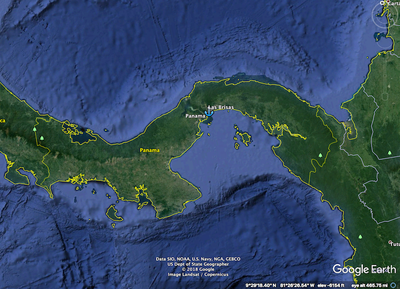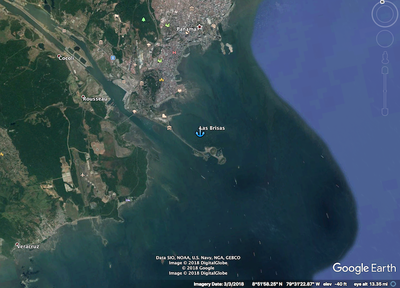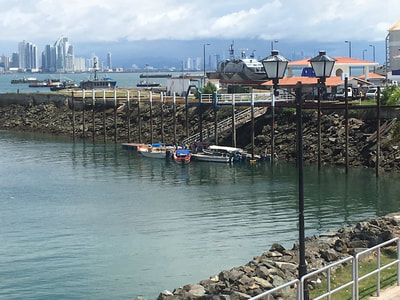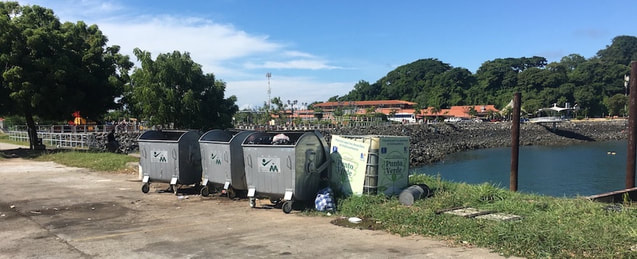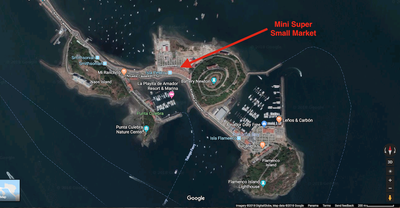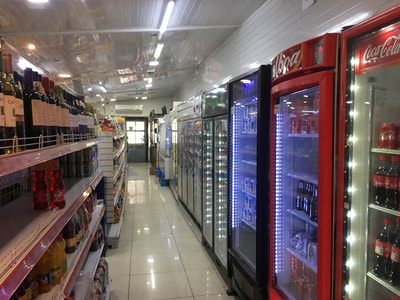Las Brisas
We anchored at 08 55.470N 79 31.868W
20ft of water
SUMMARY
Fuel - Yes
Cell Service - Yes
Wifi - No
Dingy Landing - Yes - Dock
Garbage - Yes
Potable Water - Bottle water at Mini Super
Showers - No
Laundry - Yes
Groceries- Yes - Mini Super
ATM - No
Water Taxi - No
Cell Service - Yes
Wifi - No
Dingy Landing - Yes - Dock
Garbage - Yes
Potable Water - Bottle water at Mini Super
Showers - No
Laundry - Yes
Groceries- Yes - Mini Super
ATM - No
Water Taxi - No
Las Brisas
Las Brisas was our choice for rainy season anchoring near Panama City. It offered the best protection for the prevailing southerly swell and had a free dinghy dock.
We had easy access to the city for day trips and access to a chandlery and basic services within walking distance from the anchorage.
We had easy access to the city for day trips and access to a chandlery and basic services within walking distance from the anchorage.
Anchoring
Approach
The approach is interesting because of all the traffic around the canal entrance. This is a very busy waterway 24/7 and you need to act accordingly. Most of these larger vessels are constrained in navigation in one way or another so it is up to us to keep out of the way and keep our intentions clear.
Anchor Depth – 20-60ft
The anchorage should be easy to figure out but will probably be fairly crowded. There is a mix of commercial and private boats and a mix of mooring balls and anchored vessels. The wind can come from any direction so you also need to give yourself enough room to swing and not hit any of the vessels on moorings.
We did a lap of the anchorage but didn’t find anywhere in close (better protection) that had the clearance we wanted. In the end we just went to the back of the suggested area and eventually found a spot. This left us a bit more exposed to the summer swell but with enough depth and room to swing.
Water temp and Clarity
Water temp was 83 deg when we arrived in October. Clarity was about 2 to 5ft in the anchorage with plenty of garbage and debris floating by.
The approach is interesting because of all the traffic around the canal entrance. This is a very busy waterway 24/7 and you need to act accordingly. Most of these larger vessels are constrained in navigation in one way or another so it is up to us to keep out of the way and keep our intentions clear.
Anchor Depth – 20-60ft
The anchorage should be easy to figure out but will probably be fairly crowded. There is a mix of commercial and private boats and a mix of mooring balls and anchored vessels. The wind can come from any direction so you also need to give yourself enough room to swing and not hit any of the vessels on moorings.
We did a lap of the anchorage but didn’t find anywhere in close (better protection) that had the clearance we wanted. In the end we just went to the back of the suggested area and eventually found a spot. This left us a bit more exposed to the summer swell but with enough depth and room to swing.
Water temp and Clarity
Water temp was 83 deg when we arrived in October. Clarity was about 2 to 5ft in the anchorage with plenty of garbage and debris floating by.
Dinghy Landing
The dinghy access is now a new floating dock and ramp used by some of the commercial boats on moorings and in the anchorage. Dinghies are expected to tie up on the back side so they don’t interfere with the other users.
There are armed guards at the top of the ramp who oversee dock security but we still always lock our dinghy to the dock. Make sure to leave enough painter out so that folks can move your boat aside if they need to. At low tide there is only just enough room to fit a dinghy past one another and the rocks. At any other time there is no problem. Also beware of leaving your dinghy under the ramp. If you return to the ramp at an extreme high tide, you may find your dinghy pinned underneath it.
We also make sure that everything we leave in the dinghy is locked to it. This includes the motor, the gas tank and even the oars.
There are armed guards at the top of the ramp who oversee dock security but we still always lock our dinghy to the dock. Make sure to leave enough painter out so that folks can move your boat aside if they need to. At low tide there is only just enough room to fit a dinghy past one another and the rocks. At any other time there is no problem. Also beware of leaving your dinghy under the ramp. If you return to the ramp at an extreme high tide, you may find your dinghy pinned underneath it.
We also make sure that everything we leave in the dinghy is locked to it. This includes the motor, the gas tank and even the oars.
Garbage
There are full size dumpsters just off to the side of the dinghy dock and there is even a dirty oil collection container there.
Groceries
There is a Mini Super in the plaza that is in front of you when you leave the dinghy dock. It is on the back side away from the road. It is actually fairly well stocked but be prepared for resort area pricing.
Things to Do
Big city stuff.
ANNOYANCES
Wind can keep the boat at odd angles to the swell. With the wrong combination it can be pretty rolly.
A quick 360 view of the anchorage.
Download our Google Earth KAP files for use in OpenCPN.
Download our gpx track to approach this area
OTHER ANCHORAGE GUIDES
Copyright © 2016
